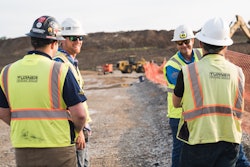
No category of construction has escaped the challenges of fuel and material price increases, labor shortages and the seemingly never-ending supply chain issues impacting the industry over the past two years.
Even as the pandemic appears to be waning, a war in Ukraine and rising Covid numbers in China have led to further price fluctuations and supply chain disruptions, bringing economic conditions into question.
Demand for work remains for many contractors, particularly at the governmental level with passage of the $1 trillion Infrastructure Investment & Jobs Act. It includes $550 billion in new funding over five years as well as reauthorizes increased transportation funding through 2026. The bill encompasses additional spending on nearly everything that constitutes physical infrastructure, including roads, bridges, power, water, sewer, high-speed internet.
Recently, the Biden administration announced an intention to restore federal regulations that require rigorous environmental review of major infrastructure projects, such as highways, pipelines and oil wells, including likely impacts on climate change and nearby communities. The reviews were scaled back by the Trump administration in a bid to fast-track projects and create jobs.
The new rule issued by the White House Council on Environmental Quality will take effect in late May and restore key provisions to the National Environmental Policy Act, a law designed to ensure community safeguards during reviews for a wide range of federal proposals, including many of the projects authorized in the infrastructure bill last fall.
In addition, the White House has directed federal agencies to ensure the new projects funded by the bill are built with U.S.-made materials including iron and steel.
Most contractors supported the bill due to high interest obtaining the work. However, due to the current economic climate, some experts question if the construction industry has the capacity to take on the flood of projects.
Funds are not expected to be divided equally but small businesses can find opportunities in many of the proposed initiatives.
Equipment World reached out to Ben Johnston, chief operating officer of Kapitus, for some insight on how small to mid-sized contractors might want to approach 2022 and beyond. Below are some of his responses:
How should smaller construction firms approach their capital investments in 2022?
Ben Johnston, chief operating officer Kapitus: Construction starts remained high during the first quarter of 2022 with strong demand in both the residential and commercial sectors. Strong demand for warehousing and manufacturing space is driving growth in overall commercial construction as consumer demand remains high and the repatriation of manufacturing drives demand. Despite the war in Ukraine and inflation concerns, we believe that a backlog of strong commercial projects should provide contractors with profitable business for the remainder of 2022 and into 2023. As a result, contractors should feel comfortable investing in the critical equipment and technology required to complete the jobs already signed. Investing in equipment and technology is likely to create efficiencies that will help reduce the need for scarce labor and may speed up construction as owning equipment reduces the lead time to rent, which has extended significantly for certain types of equipment.
How can contractors adjust to inflation?
Johnston: Inflation is appearing in every aspect of the construction business from labor costs, to fuel, to the cost of raw materials. Contractors can limit the impact of inflation by trying to vertically integrate aspects of a job that might otherwise be contracted out. For example, if a contractor typically brings in a foam insulation crew to seal a house, consider purchasing the equipment and performing the task in-house. The same concept applies for landscaping, roofing and painting. Vertical integration can help control lead times and limit markups charged by third parties. Contractors should also consider partnering with friendly local contractors to purchase common materials in bulk. Larger orders should command a better price and may be prioritized for fulfillment over smaller orders.
How can smaller construction firms capitalize on some of the proposed investments approved in the infrastructure bill?
Johnston: The projects offered in the bill are likely to be large and may be complex, so smaller, less experienced contractors may want to align themselves as subcontractors to general contractors with proven track records of winning and executing government projects.
General contractors that wish to bid on government projects must be certified to do so. Contractors should register their business with the System for Award Management (SAM.gov), where the applicant’s business information is made available to federal agencies that award contracts. Applicants can then search and apply for federal contracting opportunities through the SAM.gov website. Subcontractors interested in performing government work should seek out certified general contractors with consistent government workflow and offer to partner.
How can contractors best position themselves to take on more government contracts?
Johnston: The government has created the Contractor Performance Assessment Reporting System (CPARS) to assess the performance of a government contractor. The assessment considers cost, customer comments, quality assessments, a financial solvency assessment and performance evaluations among other items. Scoring well on previous jobs is the best way to secure additional work, and for subcontractors, partnering with general contractors that perform well on the CPARS assessment is important.
What are some of the risks contractors should try to avoid?
Johnston: Don’t take on too much. With uncertain labor markets and materials lead times, committing to too many jobs will stretch a contractor too thin, making it hard to fulfil obligations and meet expectations. When you do commit to a job, be sure to price the job with sufficient margin. Materials prices have risen rapidly over the past year and pricing should anticipate additional price increases that may arise during the project.
What do you see as an outlook for construction businesses in the near and long term?
Johnston: We expect the construction market to cool slightly from its red-hot pace in the coming months as the Federal Reserve executes on its plan to raise interest rates and higher gas prices eat into the average American budget. However, a strong job market and housing supply constraints will maintain demand for new housing, and we expect contractors to remain busy working through considerable backlogs accumulated over the past several years. We expect the high-end of the construction market to remain very strong, while the lower end will weaken more noticeably, but not to the point of serious concern.











